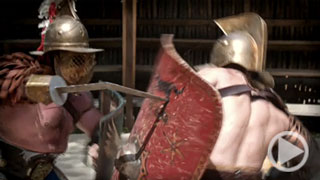- Home
- »
- Italy
- »
- Rome
- »
- The Colosseum
- »
- The Colosseum - The Colosseum under Wasser
The Colosseum Under Water
The Colosseum under water
The Romans had always had a close relationship to water: Rome’s power was based on its control over the maritime routes in the Mediterranean. Eleven aquaducts with a total length of 400 kilometers supplied Rome’s population of up to a million people with drinking water – thanks to the skill of Roman engineers. The new amphitheater with its 50,000 spectators required a huge amount of water.
Heinz-Jürgen Beste, architectural historian, German Archealogical Institute (DAI):
“We can’t say with 100 percent certainty where the water came from. There are two possibilities: the Aqua Claudia which led to the Celian Hill just above the Colosseum […] The other possibility would have been from the Esquiline Hill – that is, via the Domus Aurea, or the Baths of Titus that abutted the Colosseum on the other side.”
The huge demand for water was due less to the needs of the spectators than to Vespasian’s vision of a multiple-use stadium. He wanted to not only stage gladiator fights but gigantic sea battles, known as Naumachia(e).
Experts have long argued over whether the lower storey could actually be flooded with water. Now the consensus is that Naumachiae were actually held during the inaugural phase. In this way, Emperor Titus fulfilled his father’s dream. At that time the walls in the basement had not yet been built, so the inside of the theater could actually have been turned into a giant pool.
Heinz-Jürgen Beste:
“For the Naumachia the wooden arena and the system of supports that carried it would be dismantled – so the entire open area was available. This area of around 2700 square meters could de filled with water. However not to a height of 6 meters which is the current difference between the level of the arena and the basement, but probably only to a height of 1.5 meters. The way I see it, the water was more of a demonstrative show. The channels that bring the water into the interior don’t go down to the bottom of the basement, but are located at a height of three or four meters – and flow like large openings, like a fountain, so that the spectators would be aware of the water entering and flooding the basement.”
In other words, the surface of the water lay beneath the normal level of the floor of the arena. This meant that the view from the seats in the back was probably not very good. But it enabled small rowboats to be concealed at the edge of the basin. Cassius Dio, a Roman Senator and historian described it like this: “
Titus suddenly flooded the same theater with water and brought in horses and bulls and some other domestic animals that were trained to move in the watery element as they did on land. Additionally he had people ride in on ships – to carry out a sea battle.”
After the performance slaves drained the water. Overnight they rebuilt the floor of the arena with beams and boards in time for the next day’s thrilling fights.





